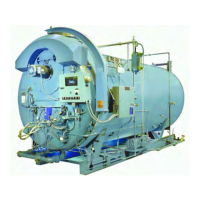Chapter 6 — Adjustment Procedures
6-2 Part No. 750-184
Note: If your boiler is equipped with a CB-HAWK ICS boiler
control system, refer to Manual No. 750-229 for specific
information regarding procedures described in this
section.
A. GENERAL
Each Cleaver-Brooks boiler is tested for correct operation before
shipment from the factory. However, variable conditions such as
burning characteristics of the fuel and operating load conditions will
require further adjustment. Contact your local qualified Cleaver-
Brooks Service representative after installation to assure correct
start-up and maximum operating efficiency and economy.
A combustion efficiency analysis made during the initial start-up
will help to determine what additional adjustments are required in
a particular installation.
Prior to placing the boiler into service, a complete inspection should
be made of all controls, connecting piping, wiring, and all fastenings
such as nuts, bolts and setscrews to be sure that no damage has
occurred, or that adjustments have not changed during shipment
and installation.
The adjustment procedures in Chapter 6 apply to standard
components furnished on steam or hot water boilers fired with gas
and/or the various grades of oil.
B. LINKAGE - MODULATING MOTOR AND AIR
DAMPER
The linkage consists of various arms, connecting rods, and swivel
ball joints that transmit motion from the modulating motor to the
metering cam(s), to the rotary air damper, and to the gas butterfly
valve, and the IFGR system used on the CB-LE.
When properly adjusted, a coordinated movement of the damper
and metering cams within the limits of the modulating motor travel
is attained to provide proper fuel-air ratios through the firing range
and NOx emission levels.
In linkage adjustments there are several important factors that must
serve as guides.
1. The modulating motor must be able to complete its full travel
range.
Do not restrict the full travel of the modulating motor. Failure to
follow these instructions could result in equipment damage.
2. Initial adjustment should be made with the motor in full closed
position, that is with the shaft on the power end of the motor in
its most counterclockwise position.

